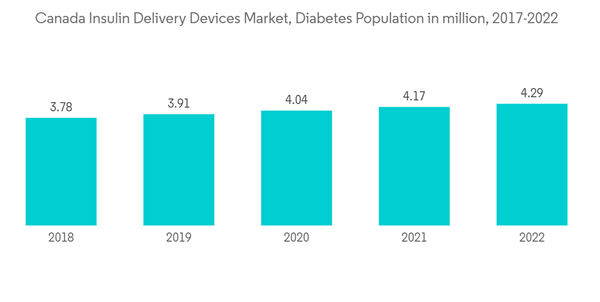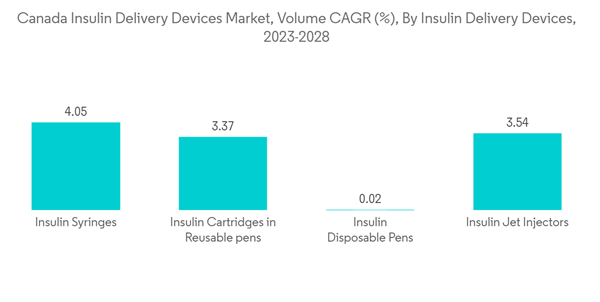The Canada Insulin Delivery Devices Market size is estimated at USD 1.27 billion in 2024, and is expected to reach USD 1.45 billion by 2029, growing at a CAGR of 2.67% during the forecast period (2024-2029).
According to Diabetes Canada 2021, since the beginning of the COVID-19 pandemic, studies have shown that diabetes was one of the major comorbidities associated with developing severe COVID-19-related adverse outcomes and mortality. Adults with diabetes who contracted COVID-19 were at higher risk of developing adult respiratory distress syndrome, pneumonia, excessive uncontrolled inflammation responses, and a hypercoagulable state.
Early reports depicted in-hospital death from COVID-19 to be 2.85 times higher in adults living with diabetes compared to patients without diabetes. According to experts, inpatient use of diabetes technology in patients with proper institutional protocols was safe and improved inpatient glycemic outcomes and played a vital role in managing hypoglycemia and hyperglycemia in hospitalized patients.
Diabetes is a chronic condition characterized by high blood glucose levels caused by the inability to produce or use insulin effectively. The main types of diabetes are type-1 diabetes and type-2 diabetes. For a patient with type 1 diabetes, insulin therapy is important for replacing the insulin the body doesn't produce. People with type-2 diabetes or gestational diabetes need insulin therapy if other treatments, such as diabetes medications and other lifestyle changes, cannot keep blood glucose levels within the desired range.
Diabetes treatment aims to maintain healthy blood glucose levels to prevent short- and long-term complications, such as cardiovascular disease, kidney disease, blindness, and lower limb amputation. Furthermore, patients attempting to control their blood glucose levels tightly to prevent the long-term complications associated with fluctuations in blood glucose levels are at greater risk for overcorrection and the resultant hypoglycemia. Achieving nominal results can be very difficult without multiple daily insulin or insulin pump therapy injections.
Technological advancements have increased over the period in Insulin delivery devices for safer and more accurate insulin administration. Medtronic recently launched an Extended infusion set that leverages advanced materials that help reduce insulin preservative loss and maintain insulin flow and stability. The set is compatible with all MiniMed 600 and 700 series insulin pumps. The new tubing connector improves insulin's physical and chemical stability and reliability of infusion site performance and reduces the risk of an infusion set occlusion. In addition to the new infusion set, the Medtronic Extended reservoir is tested and approved to keep insulin stable and safely used for up to 7 days.
Therefore, owing to the factors above, the studied market is anticipated to grow over the analysis period.
In the current year, according to Diabetes Canada, more than 5.7 million Canadians are living with diagnosed diabetes (type-1 or type-2 diabetes); however, 11.7 million Canadians are living with diabetes or prediabetes, a condition that, if left unmanaged, can develop into type-2 diabetes. Diabetes also costs the healthcare system USD 30 billion annually to treat people with diabetes.
Diabetes care can be most effective when combined with an education program that incorporates instruction for people with diabetes on healthy behavior changes in response to blood glucose values and for healthcare providers on how to adjust antihyperglycemic medications in response to blood glucose readings. As part of this education, people with diabetes should receive instruction on how and when to perform self-monitoring, record the results in an organized manner, the meaning of various blood glucose levels, and how behavior and actions affect blood glucose results.
The Canadian Diabetes Strategy is a national partnership that includes the provinces and territories, many national health organizations and interest groups, and Aboriginal communities nationwide. The purpose of the Canadian Diabetes Strategy is to articulate and establish effective diabetes prevention and control strategies for Canada. With access to the collective knowledge and experience of its various partners, the Canadian Diabetes Strategy is well-positioned to determine the needs and gaps and ensure that resources are deployed accordingly.
Therefore, the studied market is anticipated to grow over the analysis period due to rising prevalence and increasing awareness through government initiatives.
Insulin cartridges in reusable pens are an upgraded version of insulin vials. Most types of insulins are manufactured in the form of cartridges, making them easily accessible. These devices have all the functional benefits of reusable pens and are cost-effective, as these cartridges are less expensive compared to disposable insulin pens in the long run. Due to the increasing demand for insulin cartridges, most insulin device manufacturers have produced reusable insulin pens compatible with various insulin manufacturers' cartridges. Technological advancements have increased over the period in Insulin delivery devices for safer and more accurate insulin administration. Some pens are smart insulin pens that easily connect to an app on the phone to monitor blood sugar levels and remind when to take the next insulin dose.
The World Health Assembly Resolution 2022 recommended the integration of prevention and treatment of diabetes into primary health services, developing pathways for a substantial increase in access to insulin, promoting convergence and harmonizing regulatory requirements for diabetes medicines and technologies, and improving diabetes monitoring and surveillance. Furthermore, it involves the WHO to advise the Member States to ensure the uninterrupted treatment of people living with diabetes in humanitarian emergencies. This important milestone provides a global mandate for diabetes efforts for the next decade.
Thus, the abovementioned factors are expected to drive segment growth over the forecast period.
This product will be delivered within 2 business days.
According to Diabetes Canada 2021, since the beginning of the COVID-19 pandemic, studies have shown that diabetes was one of the major comorbidities associated with developing severe COVID-19-related adverse outcomes and mortality. Adults with diabetes who contracted COVID-19 were at higher risk of developing adult respiratory distress syndrome, pneumonia, excessive uncontrolled inflammation responses, and a hypercoagulable state.
Early reports depicted in-hospital death from COVID-19 to be 2.85 times higher in adults living with diabetes compared to patients without diabetes. According to experts, inpatient use of diabetes technology in patients with proper institutional protocols was safe and improved inpatient glycemic outcomes and played a vital role in managing hypoglycemia and hyperglycemia in hospitalized patients.
Diabetes is a chronic condition characterized by high blood glucose levels caused by the inability to produce or use insulin effectively. The main types of diabetes are type-1 diabetes and type-2 diabetes. For a patient with type 1 diabetes, insulin therapy is important for replacing the insulin the body doesn't produce. People with type-2 diabetes or gestational diabetes need insulin therapy if other treatments, such as diabetes medications and other lifestyle changes, cannot keep blood glucose levels within the desired range.
Diabetes treatment aims to maintain healthy blood glucose levels to prevent short- and long-term complications, such as cardiovascular disease, kidney disease, blindness, and lower limb amputation. Furthermore, patients attempting to control their blood glucose levels tightly to prevent the long-term complications associated with fluctuations in blood glucose levels are at greater risk for overcorrection and the resultant hypoglycemia. Achieving nominal results can be very difficult without multiple daily insulin or insulin pump therapy injections.
Technological advancements have increased over the period in Insulin delivery devices for safer and more accurate insulin administration. Medtronic recently launched an Extended infusion set that leverages advanced materials that help reduce insulin preservative loss and maintain insulin flow and stability. The set is compatible with all MiniMed 600 and 700 series insulin pumps. The new tubing connector improves insulin's physical and chemical stability and reliability of infusion site performance and reduces the risk of an infusion set occlusion. In addition to the new infusion set, the Medtronic Extended reservoir is tested and approved to keep insulin stable and safely used for up to 7 days.
Therefore, owing to the factors above, the studied market is anticipated to grow over the analysis period.
Canada Insulin Delivery Devices Market Trends
Rising Diabetes Prevalence in Canada is anticipated to boost the market studied.
The diabetes prevalence in Canada is expected to rise by about 2.7% over the forecast period.In the current year, according to Diabetes Canada, more than 5.7 million Canadians are living with diagnosed diabetes (type-1 or type-2 diabetes); however, 11.7 million Canadians are living with diabetes or prediabetes, a condition that, if left unmanaged, can develop into type-2 diabetes. Diabetes also costs the healthcare system USD 30 billion annually to treat people with diabetes.
Diabetes care can be most effective when combined with an education program that incorporates instruction for people with diabetes on healthy behavior changes in response to blood glucose values and for healthcare providers on how to adjust antihyperglycemic medications in response to blood glucose readings. As part of this education, people with diabetes should receive instruction on how and when to perform self-monitoring, record the results in an organized manner, the meaning of various blood glucose levels, and how behavior and actions affect blood glucose results.
The Canadian Diabetes Strategy is a national partnership that includes the provinces and territories, many national health organizations and interest groups, and Aboriginal communities nationwide. The purpose of the Canadian Diabetes Strategy is to articulate and establish effective diabetes prevention and control strategies for Canada. With access to the collective knowledge and experience of its various partners, the Canadian Diabetes Strategy is well-positioned to determine the needs and gaps and ensure that resources are deployed accordingly.
Therefore, the studied market is anticipated to grow over the analysis period due to rising prevalence and increasing awareness through government initiatives.
The Insulin Cartridges in Reusable Pens Segment holds the highest market share in the Canada Insulin Delivery Devices Market in the current year
The Insulin Cartridges in Reusable Pens Segment holds the highest market share in the Canada Insulin Delivery Devices Market in the current year and is expected to register a CAGR of about 2.9% in the market over the forecast period.Insulin cartridges in reusable pens are an upgraded version of insulin vials. Most types of insulins are manufactured in the form of cartridges, making them easily accessible. These devices have all the functional benefits of reusable pens and are cost-effective, as these cartridges are less expensive compared to disposable insulin pens in the long run. Due to the increasing demand for insulin cartridges, most insulin device manufacturers have produced reusable insulin pens compatible with various insulin manufacturers' cartridges. Technological advancements have increased over the period in Insulin delivery devices for safer and more accurate insulin administration. Some pens are smart insulin pens that easily connect to an app on the phone to monitor blood sugar levels and remind when to take the next insulin dose.
The World Health Assembly Resolution 2022 recommended the integration of prevention and treatment of diabetes into primary health services, developing pathways for a substantial increase in access to insulin, promoting convergence and harmonizing regulatory requirements for diabetes medicines and technologies, and improving diabetes monitoring and surveillance. Furthermore, it involves the WHO to advise the Member States to ensure the uninterrupted treatment of people living with diabetes in humanitarian emergencies. This important milestone provides a global mandate for diabetes efforts for the next decade.
Thus, the abovementioned factors are expected to drive segment growth over the forecast period.
Canada Insulin Delivery Devices Industry Overview
The Canadian Insulin Delivery Devices Market is semi-consolidated due to major companies operating globally and regionally, namely Medtronic, Insulet Corporation, Novo Nordisk, Sanofi, Eli Lilly and Company, etc., and other regional players.Additional Benefits:
- The market estimate (ME) sheet in Excel format
- 3 months of analyst support
This product will be delivered within 2 business days.
Table of Contents
1 INTRODUCTION
4 MARKET DYNAMICS
5 Market Segmentation
6 MARKET INDICATORS
7 COMPETITIVE LANDSCAPE
Companies Mentioned (Partial List)
A selection of companies mentioned in this report includes, but is not limited to:
- Medtronic
- F. Hoffmann-La Roche Ltd
- Insulet Corporation
- Tandem Diabetes Care, Inc.
- Ypsomed Holding AG
- Sanofi
- Becton Dickinson and Company
- Eli Lilly and Company
- Novo Nordisk
Methodology

LOADING...










